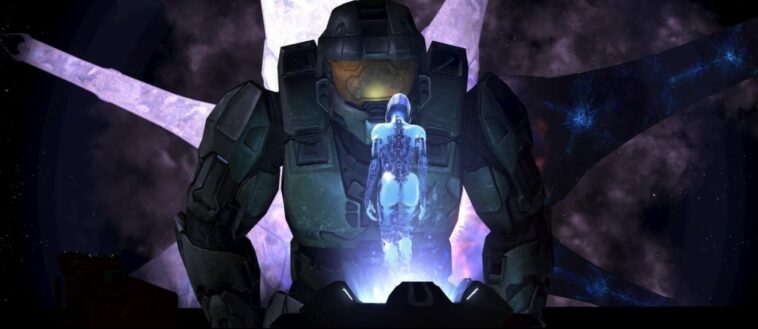The last time Halo was as popular as it is now, Spider-Man 3 was still in theaters—just look how far we’ve circled. Like a ring arcing across the heavens, the Halo series has looped back into itself with Halo Infinite, its critically acclaimed eighth game and slate-clearing soft reboot. With a TV series underway and campaign expansions in the works, it’s the perfect time to look back on the stories that started it all.
This ranking only considers the FPS campaigns, so the multiplayer suites and Halo Wars titles have no sway here. I completed each campaign on the Normal, Heroic, and Legendary difficulties to get a diverse sense of their design strengths and flaws—so this ranking is indisputably correct, whereas all others are hopelessly compromised. Just call me the Prophet of Truth, who, as we know, was 100% right about everything.
Spoilers for every campaign ahead!
8. Halo 5: Guardians
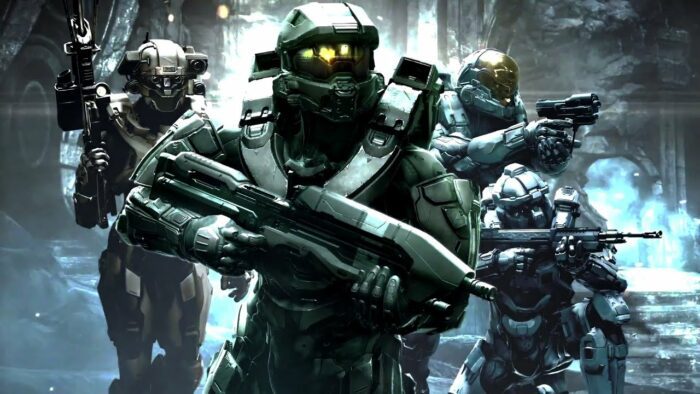
Surprising no one, Halo’s weakest campaign is the much-maligned fifth entry in the Master Chief saga. It barely even qualifies as a Master Chief story: of the fifteen campaign missions, only three feature the Chief as a playable character. The rest star Fireteam Osiris, a charmless group of Spartans who don’t move the story forward so much as they react to it. Long gone is the mystery and solitude that defined Halo in 2001—even Chief’s scant appearances surround him with faceless, indistinct teammates. From the opening cutscene, in which Osiris wipes out Covenant troops with weightless, Marvel-esque bombast, Halo 5 is a stark tonal departure not only from the series at large but especially from Halo 4, which risked a personal, downbeat, and thematically fertile descent into Chief’s fractured psyche.
The game’s narrative decisions are perplexing. Cortana’s tyrannical bent works on paper, given her history with Halsey, rampancy, and the Gravemind, but her resurrection is hasty, and it dilutes the power of her sacrifice in Halo 4. The game also repeats Halo 2’s mistake of ending on a resolution-free cliffhanger. In many ways, this is Halo’s least satisfying chapter.
But not by much. Though tonally dissonant, the new Spartan powers expand the dynamics of Halo’s moment-to-moment gameplay, complementing new enemy mechanics with melee and movement options that can be thrilling to chain together. At its best, Halo 5’s encounter design facilitates kinetic aggression, rewarding the player for making constant, full use of the arena layouts and resources. But for every well-designed battle, there’s one that only makes spatial and strategic sense if you’re playing co-op (which you can’t do locally!) or one that repeats itself several times over (looking at you, Warden Eternal). Halo’s foundational gameplay loop can’t save this campaign from mediocrity.
7. Halo 2
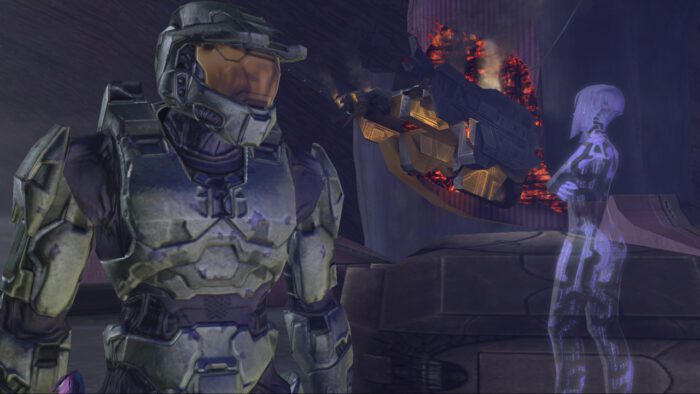
Halo 2 fell victim to an infamously rushed development cycle, and the crunch shows in the details. It’s less a mediocre campaign than a good one shot full of holes. There’s the abrupt cliffhanger, of course, cutting to credits in the middle of the climax, but the amount of small yet pervasive gameplay issues is much more frustrating.
The new enemy types are poorly designed. Drones deal damage too accurately and rapidly for an enemy that can fly over cover; brutes are bullet sponges with broken pathfinding scripts. Variations of old enemies are just as bad, if not worse: jackal snipers can kill Chief instantly before the player has a chance to see them, turning their every encounter into a placement memorization game, and the damage tuning for the Flood skews too hardy, nullifying the old-school-shooter joys of mowing down zombies that Combat Evolved still nailed in its worst levels. That all four of these enemies received mechanical overhauls in Halo 3 is telling. Even the ever-reliable elites can be unfun. Their melees can lunge through the player’s body, killing them instantly with a back smack through the chest. Minor annoyances abound. On higher difficulties, they overwhelm.
The level design takes a hit as well. Interiors are suffocatingly narrow, and the game rehashes the sealed arena structure—in which the player is locked in one place until they defeat eleventy waves of enemies—to the point of tedium. And the less said about the closing boss battle, the better. It’s a shame the gameplay is a letdown, seeing as the story is one of the series’ best. The transition to full-blown space opera, the dual perspective of the Arbiter, the dive into the Covenant’s theocratic society—all strokes of brilliance. The narrative deserves a stronger ludic experience.
6. Halo: Reach
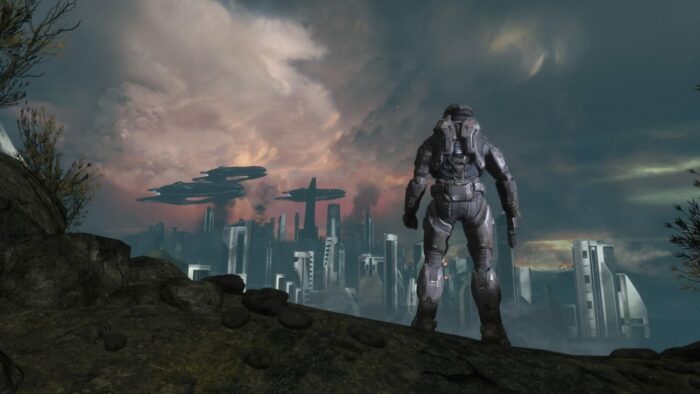
Bungie’s swan song doesn’t hit their highest note. It takes a tonal risk and succeeds in some respects: the narrative is admirably, unfailingly fatalistic. Perhaps no moment in the series is more dispiriting than Jorge sacrificing himself to destroy a Covenant carrier only for countless other carriers to arrive seconds later. The final mission—in which the player’s only objective is to survive against impossible odds until their inevitable death—is another high point. The story’s futility is palpable. But it’s plagued by aspects that threaten to dilute the tone.
The characters, for one, are the dullest hunks of armor this side of Halo 5. They’re stereotypes on a conveyer belt towards their graves. For the most part, their deaths are so emotionally empty that they come off not as tragedies but as milestones in the story. The environment design can be just as sterile—many of the locales, beholden to functioning as multiplayer maps as well, look too clean, careful, and coherent to be warzones. The campaign purports to throw you in the middle of a war, but the environments suggest that you’re seeing the start of one. Halo 3’s environments stress the planet’s dire footing much more effectively.
Concerning gameplay, Reach refines the Halo loop in some areas but throws off its balance in others. The clever, versatile elites make their welcome return as enemies, and the larger AI volume complements the architecture of the made-for-multiplayer arenas, encouraging tactical approaches to large-scale battles. Conversely, the weapon sandbox is on the weaker side, rendering a handful of firearms near-useless when other options are available. The new armor abilities also tend toward superfluity, altering the gameplay loop in specific contexts without meaningfully improving it. And the space flight segment is terrible.
5. Halo 4
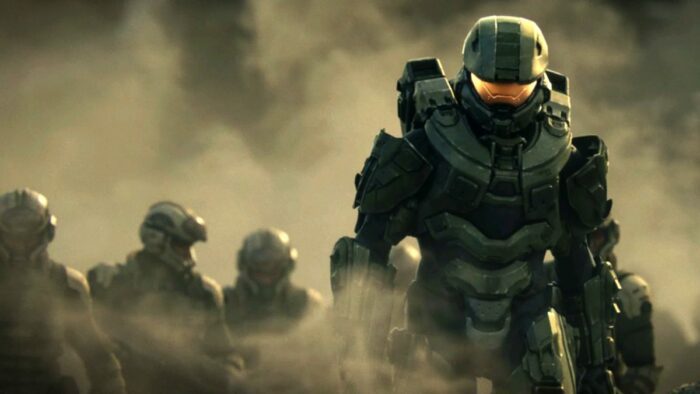
343 Industries’ first entry doesn’t reinvent the wheel. The golden triangle of guns, grenades, and melee still reigns supreme; the weapon sandbox is the same old, same old plus variations of the same old; and the vehicle segments shake up the norm in exciting yet expected ways. Its level design is the series’ most linear after Halo 2, but it bests the latter’s structure by relying on defense-storming encounters over hallways and sealed arenas. The biggest change is the new enemy type—the hate ‘em or tolerate ‘em Prometheans.
They earn some of the complaints levied against them. In theory, defense units like Watchers should put a spin on enemy prioritization, but their large shields and ability to resurrect Knights make them the top priority in every encounter, which isn’t a spin so much as a strategic mandate. The damage tuning for the Knights is so imbalanced that even the developers have admitted they’re bullet sponges, and their teleportation dodge doesn’t augment the gameplay loop; it just stalls it. That said, some good ideas still govern the Knights’ design. Their punishing yet protracted attacks and specific set of weaknesses demand a considered approach from the player, filling the tactical role of a group of enemies in a single AI. Given how dumbed-down the Covenant AI is, the challenge they present is welcome.
Halo 4 finds the series at its thematically richest. It weighs the utility of dehumanization against its existential costs, drawing an uneasy parallel between the villain and humanity—two forces that fight each other by turning people into machines. The sci-fi mythology is rushed and convoluted, but the subtext sings, and Chief and Cortana’s personal arcs take the themes to genuinely emotional places. I could do without the gross over-sexualization of Cortana, though. Talk about dehumanization.
4. Halo: Combat Evolved
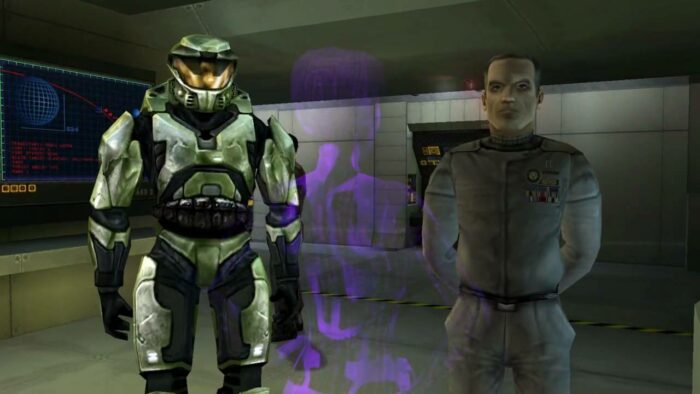
Yes, Combat Evolved is showing its age—you are too, you know—but it’s remarkable how well it holds up two decades on. What other non-PC first-person shooters from 2001 do you still play today? Ecks vs. Sever, the Doom clone based on Rotten Tomatoes’ worst-reviewed movie? I think not.
Before Halo, console shooters were generally accepted as inferior. They just didn’t handle as smoothly without a mouse and keyboard. Combat Evolved, however, perfected a control scheme that’s ubiquitous among shooters today: the left stick moves your body; the right stick pivots your perspective. The PlayStation’s Alien Resurrection tried the dual analog scheme first, but it handled too clunkily to catch on; Halo’s developers made it so smooth and intuitive that it quickly became the standard. With other first-rate features uncommon for the medium at the time, including quality voice acting and a fantastic score, Combat Evolved blew minds on release.
It also pioneered fresh mechanics for the genre, limiting loadouts to two weapons at a time, relegating grenades and melee to their own buttons, and letting players enter and exit vehicles at will. These proved ideal systems for Halo’s freewheeling combat. Its level design gets repetitive—the last three missions consist largely of old missions in reverse—but its inventive, varied encounter design offsets the sameness. Consider the flow of Assault on the Control Room: though several arenas look identical, differences in enemy type and positioning turn each room into its own little chess game. The intentionality of the encounter design is arguably still unrivaled in the series—until the Flood shows up, that is. They make for a great horror twist, but their rudimentary AI and love of low visibility drag their missions down. There’s always room to grow.
3. Halo Infinite
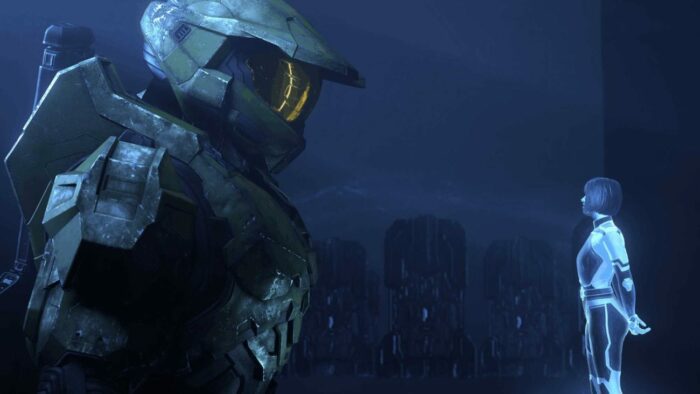
Making up for their missteps, 343 delivers the best moment-to-moment combat in the series with Infinite. The grappling hook expands the gameplay loop tremendously, closing gaps between the player and their sandbox tools of choice. Feel like nabbing a different weapon? Yank it in without deviating your path. Prefer exploding your foes from afar? Reel in a fusion coil if you’re out of rockets. Fancy your battles up close and personal? Launch your body into a throng of aliens and sling your way out before they can punish you. Other equipment options, such as the drop wall and thruster, are essential for maintaining flow on higher difficulties. Never has Halo implemented so many heat-of-the-moment options this cohesively. In concert with the series’ most diverse enemy roster, Infinite’s combat echoes the lightspeed strategizing of Doom Eternal, which, for my money, is the gold standard of the modern FPS.
The open world is a mixed bag. On one hand, it cheerfully uncorks the combat sandbox, giving the player countless medleys of weapons, vehicles, and allies to charge into battle with. On the other hand, it loses the tight, wily level design of Bungie’s best efforts. In the absence of increased structural guidance from the developers, scarce few moments reach the heights of Halo 3’s double Scarab battle or the original’s classic vehicle run. Even the missions that break from the open world feel a tad ordinary, matching neither CE’s encounter design nor Halo 3’s set piece splendor.
Infinite’s story is also hit-or-miss. It’s both personal and operatic, deftly blending the series’ main narrative modes, but its soft reboot proclivities leave it wanting as a sequel. I miss the scary, unfamiliar place where Halo 4 stranded its characters. Still, Infinite provides as sound a square one as ever.
2. Halo 3: ODST
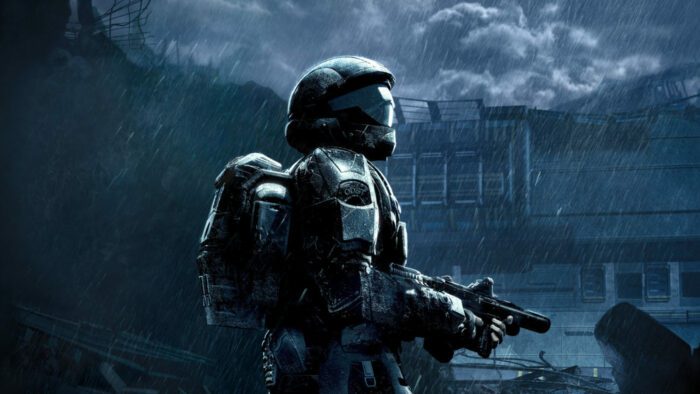
The chiaroscuro sheep of the series is too often overlooked. Joseph Staten, the lead writer of the original trilogy and creative director of ODST and Infinite, named this one his favorite, citing its ideal development cycle. With the Halo 3 engine already built, the small, close-knit team had more time to polish the basics and experiment elsewhere. The result, as no one could’ve guessed, was Halo as detective noir.
Its small scale works to its benefit. The hub world, in which the player hunts for clues that activate more traditional missions, runs into problems that Infinite would meet years later—namely, feeling like empty space between points of interest. ODST, however, is more compact, moody, and alluring. Environmental storytelling litters the streets, evoking the unseen disasters that shaped the desolate city around you. As an ODST, you’re (marginally) weaker than a Spartan, incentivizing a more cautious, observant style of exploration. The noir-inspired art design is gorgeous, and Marty O’Donnell’s score—a melancholy elegy of saxophone and piano—is his strongest work for the franchise. Atop all that is ODST’s chief genius: its audio log system.
The audio logs don’t just contextualize the story; they thematize its events, vitalizing the “war is hell” messaging with allusions to Dante’s Inferno. They’re essential to the experience. So, the game goes the extra mile to help you find them: the Superintendent, a citywide AI with a vested interest in the story, brings the city to life when you near one. Payphones ring, car sirens blare, billboards and road signs flicker in rhythm. It’s a diegetic, immersive system that still impresses today.
The game’s traditional missions are brief—slight, almost—but they distill Bungie’s level and encounter design philosophies into bite-sized gems. ODST is a greatest hits collection with a jazzy, unconventional framework.
1. Halo 3
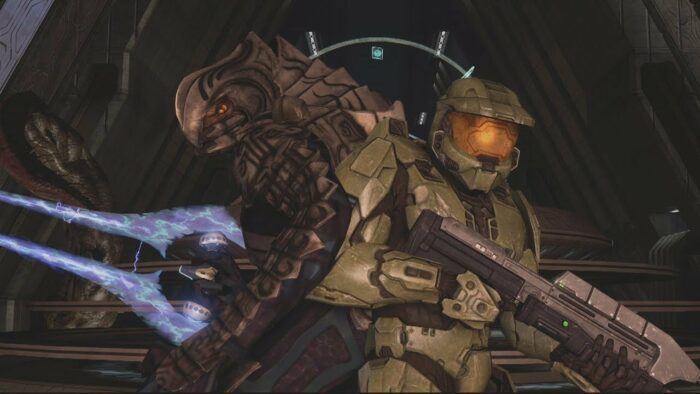
When Halo was on the top of the world, its best campaign graced the masses. The energy that Halo 3 generated could propel the series to the end of civilization. Upon replaying the game, it’s easy to see why, even if you ignore its ubiquitous multiplayer. The campaign is a euphoric, confident ride that harnesses chaos to gleeful ends.
At its heart, Halo is a sandbox shooter—though its missions skew linear, its overabundance of tools sets your playstyle free. Halo 3 is the shining example of this design. Nothing epitomizes this better than its Scarab battles, which throw giant, multi-tiered enemies and a million possible solutions at you. You can mow them down from afar with a turret, drive willy-nilly while a marine in the back seat pelts the Scarab with rockets, crash-land atop a Scarab and descend into its inner workings, hijack a high-velocity vehicle and vault yourself aboard using the level architecture, find a hidden elevator that takes you directly above the Scarab, so on and so forth for eternity. No two playthroughs of the game are the same.
Many of its set pieces are instant classics: the Flood alliance, the Warthog run, snipers on the Ark, tanks beating everything. The game is joyfully creative. You can practically feel the developers having fun. Between its tightly constructed levels, time-tested AI and mechanics, and grandiose, conclusive story, Halo 3 is a hell of a thriller, if not from end to end. Cortana is a clunker of a mission—even the developers have admitted it—and the story favors spectacle over coherence. But even if the campaign falls short of excellence, it comes closer than any of its kin. You have to—and should—play it to believe it.

